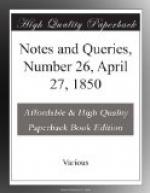With respect to the legal definition of the modern chapel, I may mention that, in stat. 7 & 8 Geo. IV. c. 29. s. 10., it signifies, according to Mr. Stephens (Eccl. Statutes, p. 1357.), “a chapel where the rites and ceremonies of the Church of England are performed, and does not include the chapels of Dissenters.” In stat. 7 & 8 Geo. IV. c. 30., we read, notwithstanding, of “any chapel for the religious worship of persons dissenting from the United Church of England and Ireland.”
C.H.
St. Catharine’s Hall, Cambridge.
Chapels (No. 20. p. 333., and No. 23. p. 371.).—The opinion of the “BARRISTER” that this term had come into use as a designation of dissenting places of worship from no “idea of either assistance or opposition to the Church of England,” but only as a supposed means of security to the property, is probably correct. Yet it is likely different reasons may have had weight in different places.
However, he is mistaken in “believing that we must date the adoption of that term from about” forty years ago. I am seventy-six years old, and I can bear testimony, that from my infancy it was the term universally employed in Yorkshire, Derbyshire, Cheshire, Lancashire, and, I think probable, in the more northern counties. In common speech, it was used as the word of discrimination from the Methodist places of worship, which bore the name of Meeting-houses, or, more generally, Meetings. But within the period (forty years) assigned by your learned correspondent, I think that I have observed the habit to have extensively obtained of applying the term Chapels to the latter class of places.
I have abundant evidence of the general use of the term for dissenting buildings, back to the seventeenth century. From my early life, I remember the current opinion to have been that Chapel was the word in use north of the Trent, and Meeting-house in Nottingham and southwards.
An eminent antiquary, the Rev. Joseph Hunter, F.S.A., could cast a full light upon this subject.
J.P.S.
Homerton, April 15.
Beaver (No. 21. p. 338.).—The earliest form of this word is fiber, which is used to signify the animal, the Castor, by Varro and Pliny. The fabulous story of the self-emasculation by which the beaver eludes pursuit, is thus introduced by Silius, in illustrating the flight of Hasdrubal:— {418}




